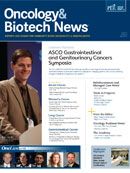Support for Dose Titration of Axitinib in AXIS Trial Results
The concept of dose titration in patients with mRCC who fail to achieve therapeutic levels on axitinib was validated by a secondary analysis.
Photo by © ASCO/Todd Buchanan 2012
Brian I. Rini, MD
The concept of dose titration in patients with metastatic renal cell carcinoma (mRCC) who fail to achieve therapeutic levels on axitinib 5 mg bid was validated by a secondary analysis of the phase III AXIS trial, presented at the ASCO 2012 Genitourinary Cancers Symposium by lead author Brian I. Rini, MD, associate professor of Medicine at the Cleveland Clinic Taussig Cancer Institute in Ohio. Outcomes and the overall frequency of adverse events were similar in the titrated and nontitrated patients taking axitinib, and both groups were superior to sorafenib.
AXIS included patients with clear-cell mRCC progressing after one of four prior regimens (sunitinib, bevacizumab plus interferon alpha, temsirolimus, or cytokines). They were randomized to axitinib starting at 5 mg bid with the option for dose titration (n=361) or standard dose and schedule of sorafenib 400 mg bid (n=362).
Primary results of the AXIS trial reported previously showed median progression-free survival (PFS) of 6.7 months with axitinib versus 4.7 months with sorafenib (HR = 0.665; P <.0001; Rini et al. Lancet. 2011;378:1931-1939).
Experience in phase II pharmacokinetic trials showed intrapatient variability on the ability to achieve therapeutic levels on standard-dose axitinib (5 mg bid). This led to a strategy of dose titration to normalize plasma levels of axitinib exposure. In the study, criteria for dose titration included no toxicity greater than grade 2 for 2 weeks or more, blood pressure <150/90 mmHg, and no antihypertensive medication. Investigators had the discretion to titrate axitinib to 7 mg, and then to 10 mg bid.
All patients randomized to axitinib started at 5 mg bid; 25% experienced dose reductions for progression; one-third had no dose change; and dose escalation occurred in 37%. Of these, 17% were escalated to 7 mg bid and 20% to 10 mg bid.
In the secondary analysis Rini presented, PFS was roughly equivalent in the titrated and nontitrated groups of axitinib-treated patients, and both groups had superior PFS versus sorafenib in this second-line setting. Overall adverse events and serious adverse events were of similar frequency in the titrated versus nontitrated groups.
“One would expect this, as both groups have similar blood levels,” Rini commented.
Some toxicities were slightly more common (at least 5%) in the nontitrated group (hypertension and proteinuria), while diarrhea, loss of appetite, nausea, hypothyroidism, and asthenia were slightly more common in the titrated group.
An effect on PFS of duration of prior exposure to sunitinib was observed for both axitinib (after 9 months of sunitinib) and sorafenib (after 6 months of sunitinib). No difference in PFS was observed in the axitinib-treated groups who had a prior response to sunitinib, but PFS improved in sorafenib-treated patients with a prior response to sunitinib.
“These are small subsets of patients,” Rini noted.
“
PFS was roughly equivalent in the titrated and nontitrated groups of axitinib-treated patients, and both groups had superior PFS versus sorafenib in this second-line setting.”
—Brian I. Rini, MD
A prospective trial in the front-line setting has completed accrual and is evaluating pharmacokinetics of axitinib more closely. Patients with mRCC are treated for 4 weeks with axitinib 5 mg bid, and then segregated to dose titration or not. Results are expected in 2013.
The moderator of the session, Daniel C. Cho, MD, assistant professor of Medicine at Beth Israel Deaconess Medical Center, Boston, Massachusetts, said, “There is increasing comfort with dose titration of axitinib over time. We are looking forward to results of the dose titration study at ASCO next year. This approach needs to be validated, and we need to study whether to extend it to other agents.” He noted that sorafenib is too toxic at higher doses, but that the newer tyrosine kinase inhibitors may be more amenable to dose titration.




